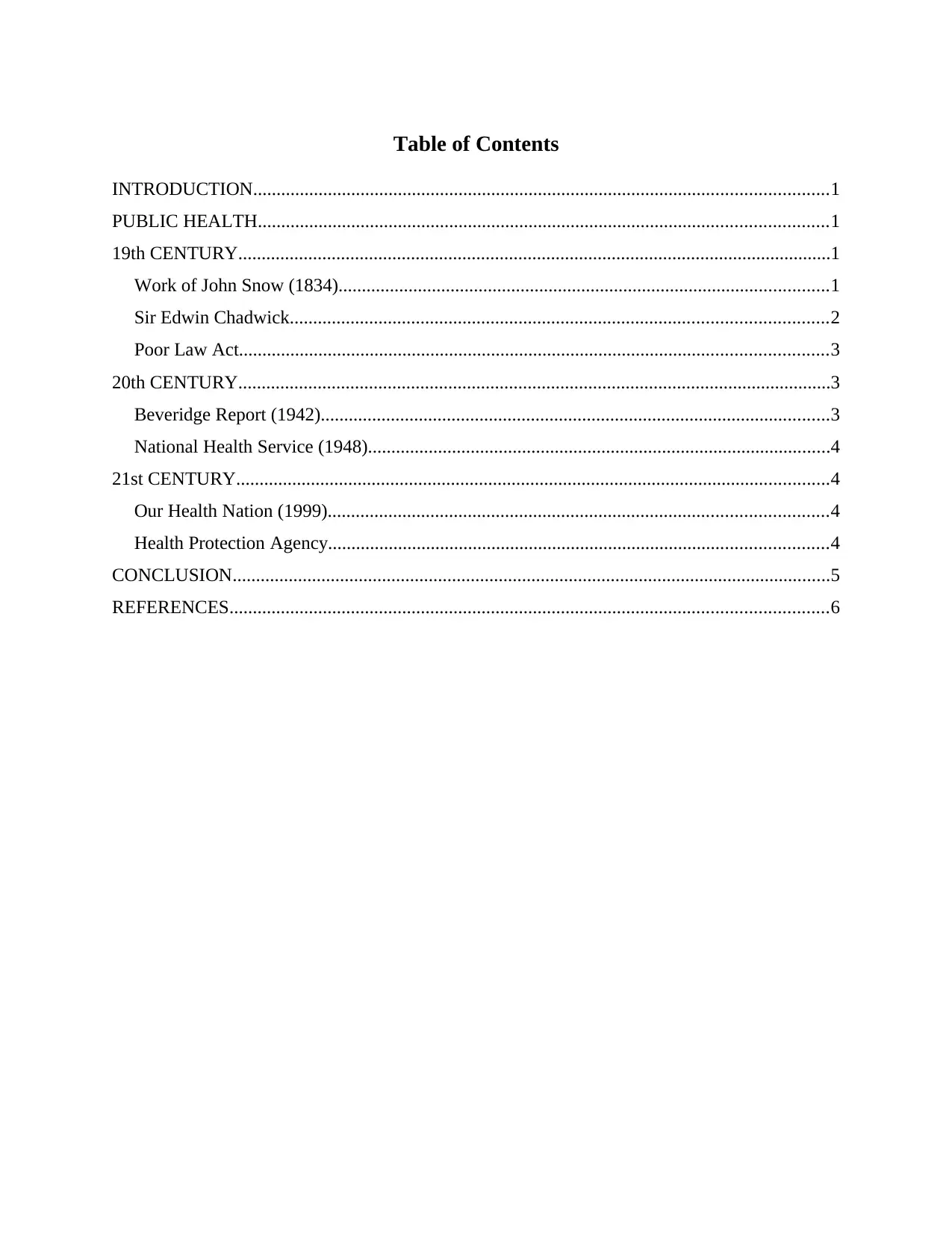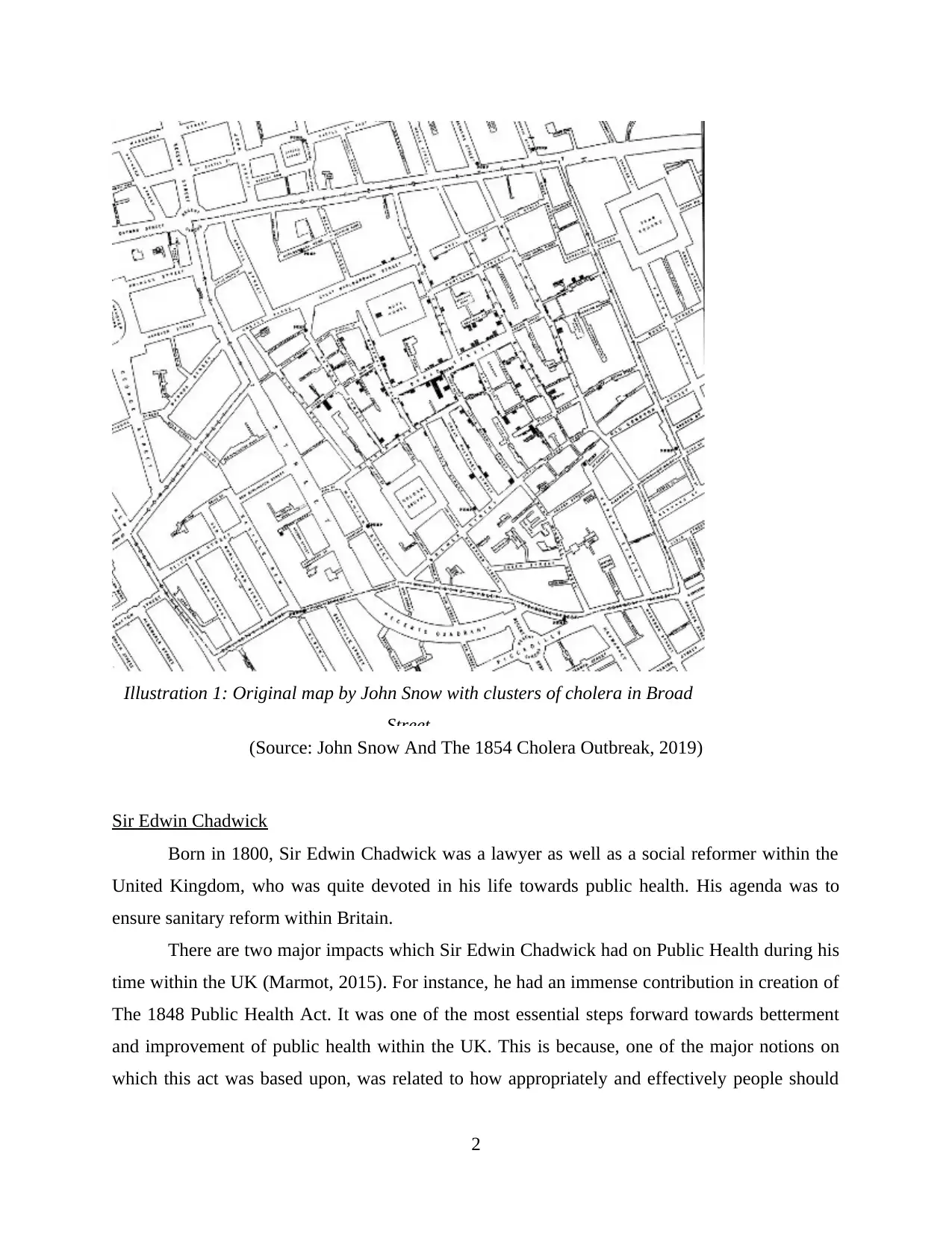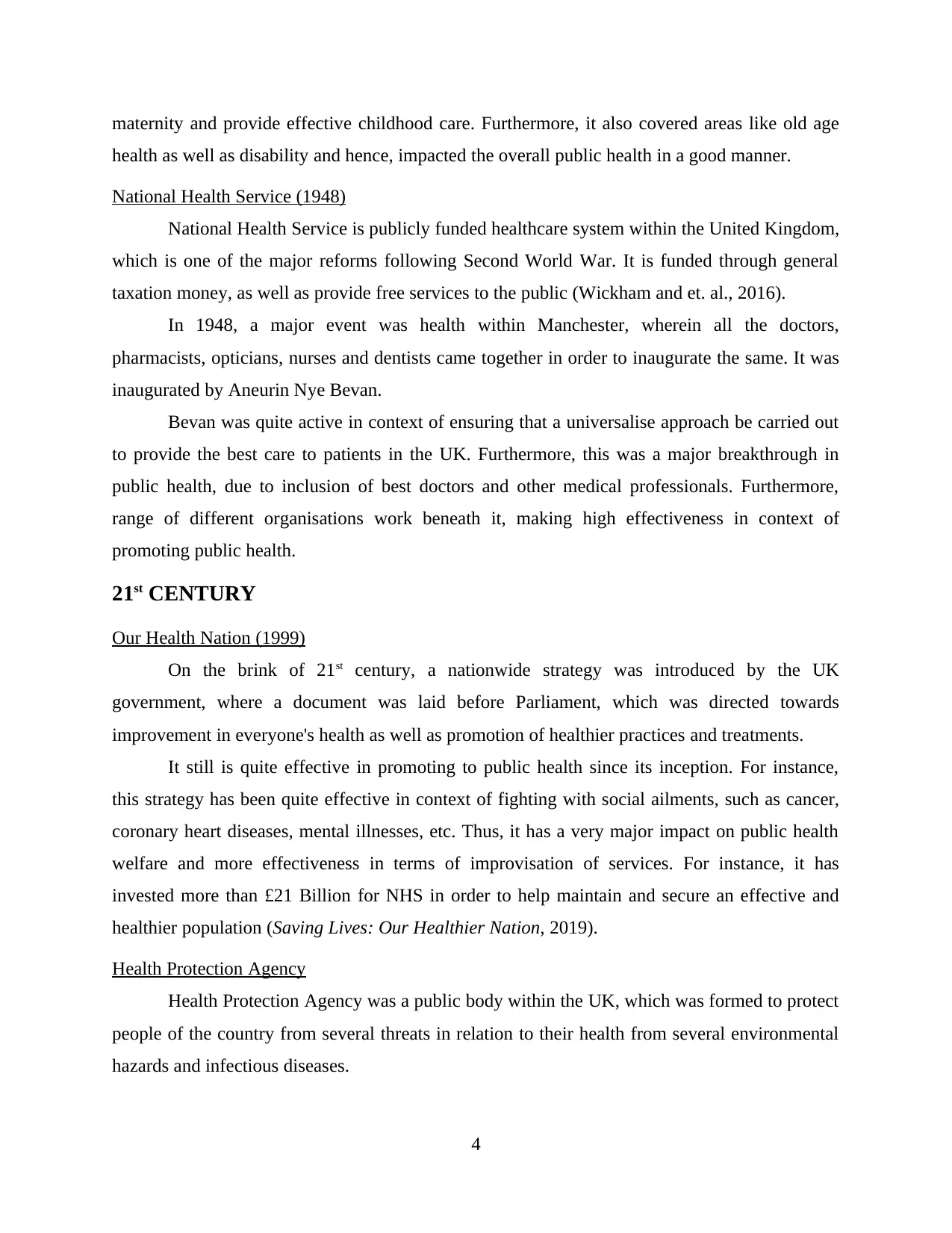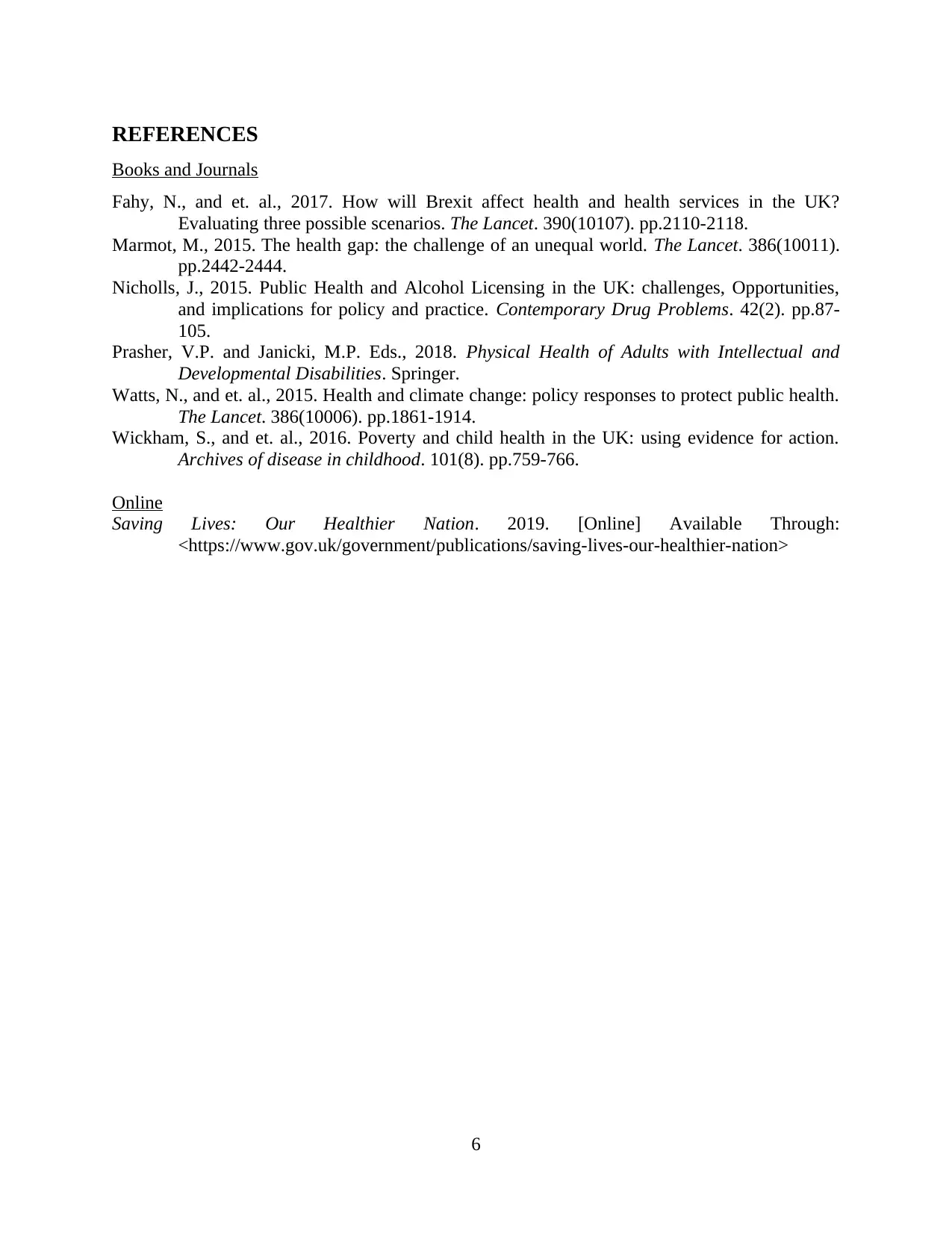Public Health in the UK: From 19th Century to Present Day Analysis
VerifiedAdded on 2021/02/21
|8
|1877
|296
Report
AI Summary
This report provides a comprehensive overview of public health in the United Kingdom, tracing its development from the 19th century to the present day. It begins by examining the contributions of key figures like John Snow and Sir Edwin Chadwick, highlighting their impact on early public health initiatives such as the identification of the source of cholera and the creation of the Poor Law Act. The report then moves into the 20th century, discussing the Beveridge Report and the establishment of the National Health Service (NHS), which significantly shaped the UK's healthcare system. Finally, it explores 21st-century developments, including the 'Our Healthier Nation' strategy and the role of the Health Protection Agency. The report concludes by emphasizing the ongoing importance of public health policies and their impact on the well-being of individuals and communities in the UK. This analysis underscores the evolution of public health, from addressing immediate threats to implementing long-term strategies for a healthier nation.

PUBLIC HEALTH
Paraphrase This Document
Need a fresh take? Get an instant paraphrase of this document with our AI Paraphraser

Table of Contents
INTRODUCTION...........................................................................................................................1
PUBLIC HEALTH..........................................................................................................................1
19th CENTURY...............................................................................................................................1
Work of John Snow (1834).........................................................................................................1
Sir Edwin Chadwick...................................................................................................................2
Poor Law Act..............................................................................................................................3
20th CENTURY...............................................................................................................................3
Beveridge Report (1942).............................................................................................................3
National Health Service (1948)...................................................................................................4
21st CENTURY...............................................................................................................................4
Our Health Nation (1999)...........................................................................................................4
Health Protection Agency...........................................................................................................4
CONCLUSION................................................................................................................................5
REFERENCES................................................................................................................................6
INTRODUCTION...........................................................................................................................1
PUBLIC HEALTH..........................................................................................................................1
19th CENTURY...............................................................................................................................1
Work of John Snow (1834).........................................................................................................1
Sir Edwin Chadwick...................................................................................................................2
Poor Law Act..............................................................................................................................3
20th CENTURY...............................................................................................................................3
Beveridge Report (1942).............................................................................................................3
National Health Service (1948)...................................................................................................4
21st CENTURY...............................................................................................................................4
Our Health Nation (1999)...........................................................................................................4
Health Protection Agency...........................................................................................................4
CONCLUSION................................................................................................................................5
REFERENCES................................................................................................................................6

INTRODUCTION
Public Health refers to the art and science of preventing several diseases, prolonging life
of individuals, as well as, promoting the overall human health by organising efforts of
individuals, communities, organisation as well as society (Nicholls, 2015). It is a highly essential
aspect for different societies as well as governments at global level. Hence, the following report
is related to the origin of public health policy, as well as, the current state of this policy within
the United Kingdom.
PUBLIC HEALTH
Within the UK, health policy has been quite widespread in recent times, however, there
has been an evident issue of the persistence of health inequalities within several regions of the
nation. Inequalities with respect to health is witnessed by several communities such as LGBTQ,
as well as people with health issues such as, schizophrenia and diabetes. However, it is quite
effective and essential to analyse origin of public health and how it got shaped within the UK,
over the years.
19th CENTURY
Work of John Snow (1834)
John Snow was a British Physician, who is one of the founding members of
epidemiology, as he identified the source of cholera in 1854, when there was a major health
outbreak within the country. Born in 1813, after becoming a surgeon, he returned back to
London and in 1838, become and effective and contributing member of Royal College of
Surgeon.
His major impact towards public health was witnessed in mid 18th century, when cholera
was assumed to be an airborne disease (Watts and et. al., 2015). However, this was quite
contradictory of beliefs of John Snow. At time of Cholera outbreak, he identified a water pump
in Broadwick Street as the source of cholera. Impact of his efforts and knowledge widely
recognised as he contributed to find source of a disease that potentially put public health into
jeopardy.
To ensure public health, he first began to talk to residents in the region and later
published his idea in journals. However, later he mapped the whole outbreak, which led to find
the source and enhance improvise public health.
1
Public Health refers to the art and science of preventing several diseases, prolonging life
of individuals, as well as, promoting the overall human health by organising efforts of
individuals, communities, organisation as well as society (Nicholls, 2015). It is a highly essential
aspect for different societies as well as governments at global level. Hence, the following report
is related to the origin of public health policy, as well as, the current state of this policy within
the United Kingdom.
PUBLIC HEALTH
Within the UK, health policy has been quite widespread in recent times, however, there
has been an evident issue of the persistence of health inequalities within several regions of the
nation. Inequalities with respect to health is witnessed by several communities such as LGBTQ,
as well as people with health issues such as, schizophrenia and diabetes. However, it is quite
effective and essential to analyse origin of public health and how it got shaped within the UK,
over the years.
19th CENTURY
Work of John Snow (1834)
John Snow was a British Physician, who is one of the founding members of
epidemiology, as he identified the source of cholera in 1854, when there was a major health
outbreak within the country. Born in 1813, after becoming a surgeon, he returned back to
London and in 1838, become and effective and contributing member of Royal College of
Surgeon.
His major impact towards public health was witnessed in mid 18th century, when cholera
was assumed to be an airborne disease (Watts and et. al., 2015). However, this was quite
contradictory of beliefs of John Snow. At time of Cholera outbreak, he identified a water pump
in Broadwick Street as the source of cholera. Impact of his efforts and knowledge widely
recognised as he contributed to find source of a disease that potentially put public health into
jeopardy.
To ensure public health, he first began to talk to residents in the region and later
published his idea in journals. However, later he mapped the whole outbreak, which led to find
the source and enhance improvise public health.
1
⊘ This is a preview!⊘
Do you want full access?
Subscribe today to unlock all pages.

Trusted by 1+ million students worldwide

Illustration 1: Original map by John Snow with clusters of cholera in Broad
Street
(Source: John Snow And The 1854 Cholera Outbreak, 2019)
Sir Edwin Chadwick
Born in 1800, Sir Edwin Chadwick was a lawyer as well as a social reformer within the
United Kingdom, who was quite devoted in his life towards public health. His agenda was to
ensure sanitary reform within Britain.
There are two major impacts which Sir Edwin Chadwick had on Public Health during his
time within the UK (Marmot, 2015). For instance, he had an immense contribution in creation of
The 1848 Public Health Act. It was one of the most essential steps forward towards betterment
and improvement of public health within the UK. This is because, one of the major notions on
which this act was based upon, was related to how appropriately and effectively people should
2
Street
(Source: John Snow And The 1854 Cholera Outbreak, 2019)
Sir Edwin Chadwick
Born in 1800, Sir Edwin Chadwick was a lawyer as well as a social reformer within the
United Kingdom, who was quite devoted in his life towards public health. His agenda was to
ensure sanitary reform within Britain.
There are two major impacts which Sir Edwin Chadwick had on Public Health during his
time within the UK (Marmot, 2015). For instance, he had an immense contribution in creation of
The 1848 Public Health Act. It was one of the most essential steps forward towards betterment
and improvement of public health within the UK. This is because, one of the major notions on
which this act was based upon, was related to how appropriately and effectively people should
2
Paraphrase This Document
Need a fresh take? Get an instant paraphrase of this document with our AI Paraphraser

participate in their personal well-being. However, one of the biggest impact which Sir Edwin
Chadwick had on public health was contributing in creation of Poor Law Act, in 1834. this Law
is based on the notion, that poor must be provided effective relief, through allowances to workers
receiving lower income.
There were several steps which he undertook in order to ensure improvisation in public
health. For instance, he improvised drainage system within the UK, along with sewers, along
with removal of all waste materials from roads, streets as well as houses. Moreover, he ensured
clean drinking water as well as he oversaw that each town has one particular medical officer.
Poor Law Act
This law was amended within the UK in 1834, and was appropriately introduced in
context of enhancing the scope of improvement within poor households (Prasher and Janicki,
2018). Thus, it ensured that poor were employed as well as housed within workhouses.
Moreover, schooling of children entering workhouses and feeding and clothing needs of poor
were also considered by the act.
Prior to 1834, the cost incurred by government to take care of poor was getting quite
expensive each year. Hence, Poor Law was later amended in order to reduce the cost and install a
system, which would be unified within the country in relation to public health.
The implementation of the law was contrast to agenda for which this law was
implemented. This is because, there were several scandals which followed the Poor Law. For
instance, inmates were found eating rotten food, which claimed that the public health was being
disregarded.
20th CENTURY
Beveridge Report (1942)
Sir William Beveridge presented the Beveridge report in 1942 to the British parliament,
which appropriately summarised several principles associated with banishing poverty from the
overall nation. The idea was to provide so much amenities and effective food and well-being
services, which demolishes the 'want' from individuals within the country.
It contributed effectively to public health, because the idea which it supported was to give
effective social expenditure utmost priority which would further contribute in safeguarding
3
Chadwick had on public health was contributing in creation of Poor Law Act, in 1834. this Law
is based on the notion, that poor must be provided effective relief, through allowances to workers
receiving lower income.
There were several steps which he undertook in order to ensure improvisation in public
health. For instance, he improvised drainage system within the UK, along with sewers, along
with removal of all waste materials from roads, streets as well as houses. Moreover, he ensured
clean drinking water as well as he oversaw that each town has one particular medical officer.
Poor Law Act
This law was amended within the UK in 1834, and was appropriately introduced in
context of enhancing the scope of improvement within poor households (Prasher and Janicki,
2018). Thus, it ensured that poor were employed as well as housed within workhouses.
Moreover, schooling of children entering workhouses and feeding and clothing needs of poor
were also considered by the act.
Prior to 1834, the cost incurred by government to take care of poor was getting quite
expensive each year. Hence, Poor Law was later amended in order to reduce the cost and install a
system, which would be unified within the country in relation to public health.
The implementation of the law was contrast to agenda for which this law was
implemented. This is because, there were several scandals which followed the Poor Law. For
instance, inmates were found eating rotten food, which claimed that the public health was being
disregarded.
20th CENTURY
Beveridge Report (1942)
Sir William Beveridge presented the Beveridge report in 1942 to the British parliament,
which appropriately summarised several principles associated with banishing poverty from the
overall nation. The idea was to provide so much amenities and effective food and well-being
services, which demolishes the 'want' from individuals within the country.
It contributed effectively to public health, because the idea which it supported was to give
effective social expenditure utmost priority which would further contribute in safeguarding
3

maternity and provide effective childhood care. Furthermore, it also covered areas like old age
health as well as disability and hence, impacted the overall public health in a good manner.
National Health Service (1948)
National Health Service is publicly funded healthcare system within the United Kingdom,
which is one of the major reforms following Second World War. It is funded through general
taxation money, as well as provide free services to the public (Wickham and et. al., 2016).
In 1948, a major event was health within Manchester, wherein all the doctors,
pharmacists, opticians, nurses and dentists came together in order to inaugurate the same. It was
inaugurated by Aneurin Nye Bevan.
Bevan was quite active in context of ensuring that a universalise approach be carried out
to provide the best care to patients in the UK. Furthermore, this was a major breakthrough in
public health, due to inclusion of best doctors and other medical professionals. Furthermore,
range of different organisations work beneath it, making high effectiveness in context of
promoting public health.
21st CENTURY
Our Health Nation (1999)
On the brink of 21st century, a nationwide strategy was introduced by the UK
government, where a document was laid before Parliament, which was directed towards
improvement in everyone's health as well as promotion of healthier practices and treatments.
It still is quite effective in promoting to public health since its inception. For instance,
this strategy has been quite effective in context of fighting with social ailments, such as cancer,
coronary heart diseases, mental illnesses, etc. Thus, it has a very major impact on public health
welfare and more effectiveness in terms of improvisation of services. For instance, it has
invested more than £21 Billion for NHS in order to help maintain and secure an effective and
healthier population (Saving Lives: Our Healthier Nation, 2019).
Health Protection Agency
Health Protection Agency was a public body within the UK, which was formed to protect
people of the country from several threats in relation to their health from several environmental
hazards and infectious diseases.
4
health as well as disability and hence, impacted the overall public health in a good manner.
National Health Service (1948)
National Health Service is publicly funded healthcare system within the United Kingdom,
which is one of the major reforms following Second World War. It is funded through general
taxation money, as well as provide free services to the public (Wickham and et. al., 2016).
In 1948, a major event was health within Manchester, wherein all the doctors,
pharmacists, opticians, nurses and dentists came together in order to inaugurate the same. It was
inaugurated by Aneurin Nye Bevan.
Bevan was quite active in context of ensuring that a universalise approach be carried out
to provide the best care to patients in the UK. Furthermore, this was a major breakthrough in
public health, due to inclusion of best doctors and other medical professionals. Furthermore,
range of different organisations work beneath it, making high effectiveness in context of
promoting public health.
21st CENTURY
Our Health Nation (1999)
On the brink of 21st century, a nationwide strategy was introduced by the UK
government, where a document was laid before Parliament, which was directed towards
improvement in everyone's health as well as promotion of healthier practices and treatments.
It still is quite effective in promoting to public health since its inception. For instance,
this strategy has been quite effective in context of fighting with social ailments, such as cancer,
coronary heart diseases, mental illnesses, etc. Thus, it has a very major impact on public health
welfare and more effectiveness in terms of improvisation of services. For instance, it has
invested more than £21 Billion for NHS in order to help maintain and secure an effective and
healthier population (Saving Lives: Our Healthier Nation, 2019).
Health Protection Agency
Health Protection Agency was a public body within the UK, which was formed to protect
people of the country from several threats in relation to their health from several environmental
hazards and infectious diseases.
4
⊘ This is a preview!⊘
Do you want full access?
Subscribe today to unlock all pages.

Trusted by 1+ million students worldwide

It was formulated by the UK government in 2003, and the agenda for the same was to
appropriately and effectively provide an integrated approach towards protection of public health
within the country. This was done through provision of several emergency services, support from
local authorities and NHS, along with the Department of Health.
Its major impact on public health, before its dissolution in 2013, was that not just
existing, but new and emerging threats related to public health was also anticipated by this
agency, such as bioterrorism, inclusive of several strategies to deal with the same. This helped
the whole nation in getting an assurance towards overall betterment and improvement, hence,
impacting the public health with effective positivity (Fahy and et. al., 2017).
CONCLUSION
Thus, it is concluded from the above information, that public health within a country is
very much essential to be taken into consideration by government, communities and individuals,
in order to ensure effectiveness in health and well-being standards of individuals. Moreover,
analysis of its origin and current status, allows in a better understanding of its roots, several
practices undertaken for its implementation throughout the years, as well as current practices
being followed to ensure health and well-being of individuals.
5
appropriately and effectively provide an integrated approach towards protection of public health
within the country. This was done through provision of several emergency services, support from
local authorities and NHS, along with the Department of Health.
Its major impact on public health, before its dissolution in 2013, was that not just
existing, but new and emerging threats related to public health was also anticipated by this
agency, such as bioterrorism, inclusive of several strategies to deal with the same. This helped
the whole nation in getting an assurance towards overall betterment and improvement, hence,
impacting the public health with effective positivity (Fahy and et. al., 2017).
CONCLUSION
Thus, it is concluded from the above information, that public health within a country is
very much essential to be taken into consideration by government, communities and individuals,
in order to ensure effectiveness in health and well-being standards of individuals. Moreover,
analysis of its origin and current status, allows in a better understanding of its roots, several
practices undertaken for its implementation throughout the years, as well as current practices
being followed to ensure health and well-being of individuals.
5
Paraphrase This Document
Need a fresh take? Get an instant paraphrase of this document with our AI Paraphraser

REFERENCES
Books and Journals
Fahy, N., and et. al., 2017. How will Brexit affect health and health services in the UK?
Evaluating three possible scenarios. The Lancet. 390(10107). pp.2110-2118.
Marmot, M., 2015. The health gap: the challenge of an unequal world. The Lancet. 386(10011).
pp.2442-2444.
Nicholls, J., 2015. Public Health and Alcohol Licensing in the UK: challenges, Opportunities,
and implications for policy and practice. Contemporary Drug Problems. 42(2). pp.87-
105.
Prasher, V.P. and Janicki, M.P. Eds., 2018. Physical Health of Adults with Intellectual and
Developmental Disabilities. Springer.
Watts, N., and et. al., 2015. Health and climate change: policy responses to protect public health.
The Lancet. 386(10006). pp.1861-1914.
Wickham, S., and et. al., 2016. Poverty and child health in the UK: using evidence for action.
Archives of disease in childhood. 101(8). pp.759-766.
Online
Saving Lives: Our Healthier Nation. 2019. [Online] Available Through:
<https://www.gov.uk/government/publications/saving-lives-our-healthier-nation>
6
Books and Journals
Fahy, N., and et. al., 2017. How will Brexit affect health and health services in the UK?
Evaluating three possible scenarios. The Lancet. 390(10107). pp.2110-2118.
Marmot, M., 2015. The health gap: the challenge of an unequal world. The Lancet. 386(10011).
pp.2442-2444.
Nicholls, J., 2015. Public Health and Alcohol Licensing in the UK: challenges, Opportunities,
and implications for policy and practice. Contemporary Drug Problems. 42(2). pp.87-
105.
Prasher, V.P. and Janicki, M.P. Eds., 2018. Physical Health of Adults with Intellectual and
Developmental Disabilities. Springer.
Watts, N., and et. al., 2015. Health and climate change: policy responses to protect public health.
The Lancet. 386(10006). pp.1861-1914.
Wickham, S., and et. al., 2016. Poverty and child health in the UK: using evidence for action.
Archives of disease in childhood. 101(8). pp.759-766.
Online
Saving Lives: Our Healthier Nation. 2019. [Online] Available Through:
<https://www.gov.uk/government/publications/saving-lives-our-healthier-nation>
6
1 out of 8
Your All-in-One AI-Powered Toolkit for Academic Success.
+13062052269
info@desklib.com
Available 24*7 on WhatsApp / Email
![[object Object]](/_next/static/media/star-bottom.7253800d.svg)
Unlock your academic potential
Copyright © 2020–2025 A2Z Services. All Rights Reserved. Developed and managed by ZUCOL.

